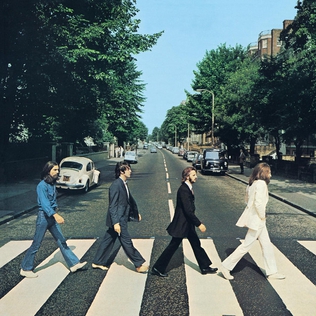
The Beatles Abbey Road: Abbey Road is the eleventh album by the English rock band the Beatles, released on 26 September 1969 in the United Kingdom and on 1 October 1969 in the United States. The recording sessions for the album were the last in which all four Beatles participated. Although Let It Be was the final album that the Beatles completed before the bands split in April 1970, most of the album had been recorded before the Abbey Road sessions began. A double A-side single from the album, "something"/"Come Together", released in October, topped the Billboard chart in the US.It is the only original UK Beatles album sleeve to show neither the artist name nor the album title on its front cover, which was Kosh's idea, despite EMI claiming the record would not sell without this information. He later explained that "we didn't need to write the band's name on the cover ... They were the most famous band in the world".The image of the Beatles on the crossing has become one of the most famous and imitated in recording history. The crossing is a popular destination for Beatles fans and there is a webcam featuring it. In December 2010, the crossing was given grade 2 listed status for its "cultural and historical importance"; the Abbey Road studios themselves had been given similar status earlier in the year. In 2013, Kolkata police launched a traffic safety awareness advertisement against jaywalking, using the cover and a caption that read: "If they can, why can't you?" The cover has been parodied on several occasions, not least from McCartney's own 1993 live album, Paul is live. The Red Hot Chilli Peppers' The Abbey Road EP parodies the cover with the band crossing a similar zebra crossing near-naked, though the musical content is different.

The Clash London Calling:
The album's front cover features a photograph of bassist Paul Simenon smashing his Fender Precision Bass against the stage at The Palladium in New York City on 20 September 1979 during the Clash US tour. Penny Smith, who photographed the band for the album, originally did not want the photograph to be used. She thought that it was too out of focus, but Strummer and graphic designer Ray Lowry thought it would make a good album cover in 2002, Smith's photograph was named the best rock and roll photograph of all time by Q magazine.
The cover artwork was designed by Lowry and was an homage to the design of Elvis Presley's self-titled debut album. The cover was named the ninth best album cover of all time by Q magazine in 2001.

Nirvana Nevermind:By January 1992, it had replaced Michael Jackson's album dangerous at number one on the Billboard 200 chart. The album also produced three other successful singles: "Come as You Are", "Lithium", and "In Bloom". The Recording Industry Association of America has certified the album Diamond (over 10 million copies shipped), and the album has sold over 30 million copies worldwide. Nevermind was in part responsible for bringing alternative rock to a large mainstream audience, and has been ranked highly on lists of the greatest albums of all time by publications such as Rolling stone and Time.
The Nevermind album cover shows a circumcised baby boy, alone underwater with a US dollar bill on a fishhook just out of his reach. According to Cobain, he conceived the idea while watching a television program on water births with Grohl. Cobain mentioned it to Geffen's art director Robert Fisher .An alternate cover without the penis was discussed, as they were afraid that it would offend people, but relented when Cobain made it clear that the only compromise he would accept was a sticker covering the penis that would say, "If you're offended by this, you must be a closet paedophile.". Nevermind was certified Gold and Platinum by the Recording Industry Association of America in November 1991, and was certified Diamond in March 1999. It was also certified Diamond in Canada (1,000,000 units sold) by the Canadian Recording Industry Association in March 2001[ and four times Platinum in the United Kingdom.[




